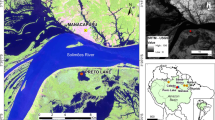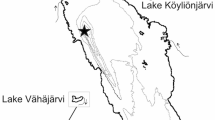Abstract
Major biogeochemical processes in the newly created, shallow Lake Agmon (Hula Valley, northern Israel) were investigated from 1994 to 1996. Sediment cores, lake water and porewater were analyzed for chemical composition and spatial distribution. Sediment analyses revealed that Lake Agmon has two different sediment types: peat sediments in the northern and central parts, and marls in the southern part. The basic composition of the lake's water was controlled mainly by the mixing of two distinct water types (Jordan River and water drainage), and by evaporation. About 3/4 of the lake water originated from the Jordan Inlet, a quarter through the Z Canal Inlet (peat drainage) and a minor amount from groundwater seepage. Lake Agmon is unique among freshwater wetlands owing to its high SO 2−4 content, which is ca. 1/3 that of sea water. This characteristic is ascribed to the dissolution of secondary gypsum, formed in the peat soils since the drainage of the historic Hula Marsh. Leaching gypsum from the shallow sediments during the first few months after flooding was followed by a later stage of constant diffusion and advection of SO 2−4 from gypsum dissolution in deeper sediments. Gypsum dissolution in lake sediments contributed ca. half of the SO4 2− and Ca2+ inputs to the lake. The concomitant increase of Ca2+ combined with alkalinity release due to organic matter decomposition in the sediments led to the precipitation of CaCO3. This precipitation was enhanced by photosynthesis, particularly during summers, and consumed about a tenth of the Ca2+ and third of the alkalinity outputs from the lake. Iron-hydroxide was the main agent for microbial oxidation of organic matter, surpassing by far the role of sulfate, nitrate and manganese as electron acceptors. The produced Fe2+ was transported upward by diffusion and advection and oxidized to ferric iron at the sediment-water interface. There is evidence, however, that some sulfate was reduced, but most of the produced sulfide reacted with ferrous iron and accumulated in the sediments as FeS minerals. Therefore, despite high sulfate concentrations, the high iron availability restricted release of toxic sulfides into the water and thereby served to maintain reasonable water quality.
Similar content being viewed by others
References
Agron, N. and Fleisher, E. 1976. Quality and Distribution of Peat in the Hula Valley. Report No. Hydro/1/76, Geological Survey of Israel, Jerusalem.
Avnimelech, Y., Dasberg, S., Harpaz, A. and Levin, I. 1978. Prevention of nitrate leakage from the Hula Basin, Israel: a case study in watershed management. Soil Science 125: 233-239.
Bein, A. 1986. Early evolution and transformation of organic matter in the active continental Jordan Rift Valley. Org. Geochem. 10: 751–757.
Bein, A. and Nielsen, H. 1988. Sulfur diagenesis in freshwater lignites (Hula Basin, Israel): implication for S-C relationships in organic sediments. J. Geol. Soc. Lon. 145: 133-136.
Berner, R.A. 1980. Early Diagenesis: a Theoretical Approach. Princeton University Press, Princeton.
Boyle, D.E. 1994. Design of a seepage meter for measuring groundwater fluxes in the non littoral zones of lakes: evaluation in a boreal forest lake. Limnol. Oceanogr. 39: 670-681.
Brenner, S., Ikan, R., Agron, N.A. and Nissenbaum, A. 1978. Hula Valley peat: review of chemical and geochemical aspects. Soil Science 125: 226-232.
Canfield, D.E. 1989. Reactive iron in marine sediments. Geochim. Cosmochim. Acta 53: 619–632.
Cline, J.D. 1969. Spectrophotometric determination of hydrogen sulfide in natural waters. Limnol. Oceanogr. 14: 454-458.
Cowgill, U.M. 1969. The waters of Merom: a study of Lake Huleh. 1. Introduction and general stratigraphy of a 54-m core. Arch. Hydrobiol. 66: 249-272.
Cowgill, U.M. 1973. The waters of Merom: a study of Lake Huleh. 2. The mineralogy of a 54-m core. Arch. Hydrobiol. 71: 421- 474.
Elderfield, H. 1985. Element cycling in bottom sediments. Phil. Trans. R. Soc. London. A 315: 19-23.
Gambrell, R.P. and Patrick, W.H. Jr. 1978. Chemical and microbiological properties of anaerobic soils and sediments. In:Hook, D.D. and R.M.M. Crawford (eds). Plant Life in Anaerobic Environments. pp 375-423. Ann Arbor Sci. Publ., Ann Arbor.
Goldhaber, M.B. and Kaplan, I.R. 1975. Controls and consequences of sulfate reduction rates in recent marine sediments. Soil Sci. 119: 42-55.
Grasshof, K. 1983. Determination of oxygen. In:Grasshoff, K., Ehrhardt, M. and K. Kremling (eds). Methods of Sea Water Analysis. pp. 59-70. Verlag Chemie, Bazel.
Hambright, K.D., Bar-Ilan, I. and Eckert, W. 1998. General water chemistry and quality in a newly-created subtropical wetland lake. Wetlands Ecol. Managmt. 6: 121-132.
Hambright, K.D. and Zohary, T. 1998. Lakes Hula and Agmon: destruction and creation of wetland ecosystems in Northern Israel. Wetlands Ecol. Managmt. 6: 83-89.
Hesslein, R.M. 1976. An in situsampler for close interval pore water studies. Limnol. Oceanogr. 21: 912-914.
Hines, M.E., Knollmeyer, S.L. and Tugel, J.B. 1989. Sulfate reduction and other sedimentary biogeochemistry in a northern New England salt marsh. Limnol. Oceanogr. 34: 578-590.
Horowitz, A. 1973. Development of the Hula basin, Israel. Isr. J. Earth Sci. 22: 107-139.
Hutchinson, G.E. and Cowgill, U. 1973. The waters of Merom: a study of Lake Huleh. 3. The major chemical constituents of a 54-m core. Arch. Hydrobiol. 72: 145-185.
Kafri, U. and Lang, B. 1979. Hula Lignite Project: Geological Report. Isr. Geol. Surv. Rep. Hydro/3/79, Jerusalem.
Kaplan, D., Oron, T. and Gutman, M. 1998. Development of macrophytic vegetation in the Agmon wetland of Israel by spontaneous colonization and reintroduction. Wetlands Ecol. Managmt. 6: 143-150.
Langmuir, D. 1997. Aquatic Environmental Geochemistry. Prentice-Hall, New Jersey.
Lazar, B. and Erez, Y. 1992. Carbon geochemistry of marine-derived brines: I. 13C depletion due to intense photosynthesis. Geochim. Cosmochim. Acta 56: 335-345.
Luther, G.W. III and Church, T.M. 1988. Seasonal cycling of sulfur and iron in porewaters of a Delaware salt marsh. Mar. Chem. 23: 295-309.
Luther, G.W., III, Kosta, J.E., Church, T.M., Sulzberger, B. and Stumm, W. 1992. Seasonal iron cycling in the salt-marsh sedimentary environment: the importance of ligand complexes with Fe(II) and Fe(III) in the dissolution of Fe(III) minerals and pyrite, respectively. Mar. Chem. 40: 81-103.
Markel, D., Sass, E., Lazar, B. and Bein, A. 1997. Iron and sulfur interactions in anaerobic sediments: toxicity to macrophytic vegetation in the newly created AgmonWetland, Northern Israel. In:Iskandar, I.K., Hardy, S.E., Chang, A.C. and Pierzynski, G.M. (eds), Proc. 4th Int. Conf. Biogeochemistry of Trace Elements. pp. 5270–528. Berkeley, CA.
McConnaughey, T.A., LaBaugh, J.W., Rosenberry, D.O., Striegel, R.G., Reddy, M.M., Schuster, P.F. and Carter, V. 1994. Carbon budget for a groundwater fed lake: calcification supports summer photosynthesis. Limnol. Oceanogr. 39: 1319-1332.
Mitsch, W.J. and Gosselink, J.G. 1993. Wetlands. Van Nostrand Reinhold, New York.
Neuman, S.P. and Dasberg, S. 1977. Peat hydrology in the Hula Basin, Israel: II. Subsurface flow regime. J. Hydrol. 32: 241-256.
Ponnamperuma, F.N. 1972. The chemistry of submerged soils. Adv. Agron. 24: 29-96.
Ravikovitch, S. 1948. Peat soils and soils rich inorganic matter in the Huleh Valley. Agric. Res. Station, Bull. No. 47, Rehovot.
Rickard, D.T. 1975. Kinetic and mechanisms of pyrite formation at low temperatures. Am. J. Sci. 275: 636-652.
Ronen, D., Magaritz, M., Paldor, N. and Bachmat., Y. 1986. The behavior of groundwater in the vicinity of water table evidenced by specific discharge profiles. Water Resour. Res. 22: 1217-1224.
Sass, E. and Ben-Yaakov, S. 1977. The carbonate system in hypersaline solutions: Dead Sea brines. Mar. Chem. 5: 183-199.
Shoham, D. and Levin, I. 1968. Subsidence in the reclaimed Hula Swamp area in Israel. Isr. J. Agric. Res. 18: 15-18.
Smith, S.V. 1973. Carbon dioxide dynamics: a record of organic carbon production, respiration, and calcification in the Eniwetok reef flat community. Limnol. Oceanogr. 18: 106-120.
Smolders, A.J.P., Roelofs, M.J.G. and den Hartog, C. 1996. Possible causes for the decline of the water soldier (Stratiotes aloides L.) in the Netherlands. Archiv. Hydrobiol. 136: 327-342.
Tsipris, J. and Meron, M. 1998. Climatic and hydrological aspects of the Hula restoration project. Wetlands Ecol. Managmt. 6: 91- 101.
Zohary, T., Fishbein, T., Kaplan, B. and Pollingher, U. 1998. Phytoplankton-metaphyton seasonal dynamics in a newly-created subtropical wetland. Wetlands Ecol. Managmt. 6: 133- 142.
Author information
Authors and Affiliations
Rights and permissions
About this article
Cite this article
Markel, D., Sass, E., Lazar, B. et al. Biogeochemical evolution of a sulfur-iron rich aquatic system in a reflooded wetland environment (Lake Agmon, northern Israel). Wetlands Ecology and Management 6, 103–120 (1998). https://doi.org/10.1023/A:1008407800060
Issue Date:
DOI: https://doi.org/10.1023/A:1008407800060




